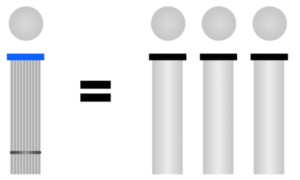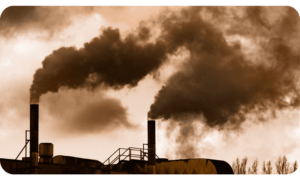
Reducing Maintenance Time In Dust Collection Systems
Whether it is industrial production or not, there are moments in every sector where the planned activities do not take place within the desired time

One of the most important issues in dust collection system design is the dust conveying velocity (in other words, in-duct velocity). It is necessary to understand the importance of dust conveying velocity and its effect on the working performance of dust collection systems. Too slow or too fast movement of the air in the ducts causes undesirable consequences. For example, when the dust transport speed is very slow, dust may accumulate in the ducts and this may cause accidents such as fire, explosion, or falling off of the ducts. If the dust transport speed is too fast, it increases the pressure loss along the line, causing an unnecessary increase in energy consumption and unnecessary increases in both the initial investment cost and operation and maintenance costs.
Optimum conveying speeds are determined depending on the type of dust to be transported and environmental conditions. Optimum transport speed selections should be made by the competent system and design engineers. Systems designed by incompetent people can cause dangerous results and increased costs.
ACGIH Industrial Ventilation Guide
The Industrial Ventilation Guide prepared by ACGIH (American Conference of Governmental Industrial Hygienists) is an important resource used to determine the proposed design practices in industrial ventilation. This guide is an important guide for system and project designers about transport speeds.
Problems Caused by Too High or Too Low Transport Speeds
The main purpose of dust collection and filtration systems is to extract the unwanted dust, fume, oil mist, and gases released as a result of industrial processes from their source and carry them to the filter unit without spreading to the environment. An effective filter unit can clean the polluted air coming to the filter unit, and release the clean air to the atmosphere or return it to the indoor environment depending on the process. The main components of the dust collection systems are the extraction hood, dust transport ducts, filter unit/units, fan, and exhaust stack that catch the pollution. (Of course, depending on the process, components such as rotary valves, spark detection and extinguishing system, etc. can also be found.) All of these components work together in an effective dust collection system. In other words, a design error in any of them affects the operating performance of the whole system. The subject of this article is the design of dust conveying ducts.
2 data are critical when designing dust transport ducts;
– Air volume to be transported per unit hour in the duct (Air Flow)
– Dust Conveying Velocity
You can browse the article on the link regarding the required airflow calculation.
After the required airflow has been calculated, the dust transport speed should be determined. The dust transport speed should be determined by competent professionals, as stated above. As a general rule, the dust conveying velocity increases as the density of the dust to be transported increases. For example, lead dust is a heavy powder, and therefore, when transported, the dust transport speed is determined high. Otherwise, lead dust will settle in the duct and begin to accumulate. This situation poses serious risks in terms of occupational safety. Welding fume, on the other hand, is light dust, and therefore the dust transport speed can be relatively lower while being transported.
To summarize, If the dust transport speed is lower than it should be, (due to dust accumulation in the duct);
– Occupational accidents will occur as a result of the weight of the duct is higher than they suppose to carry
– Fire and explosion will occur, as a result of the accumulated dust is a flammable/combustible dust,
– Ducts will be punctured, (depending on the characteristics of the dust, creating corrosive effects)
– Pressure loss will increase along the duct line because the accumulated dust will narrow down the cross-section area of the duct.
If the dust transport speed is higher than it should be;
– Ducts will be punctured because abrasive dust can erode the duct material. As a result, frequent duct repairs and changes will be required.
– Energy consumption and the initial investment will increase. Because high conveying speeds mean high pressure losses. In order to overcome these high pressure losses, larger motors have to be applied.
When Preparing a Ducting Project, Consider Possible Changes in Air Volume
After deciding on the required airflow and dust transport speed, the project of the dust conveying ducts can be made. The dust transport ducting project is a project in which the diameters of the dust transport duct are determined and prepared according to the needs. This project should be done by competent designers and engineers. Otherwise, undesirable results such as high energy consumption, occupational health and safety risks, may occur.
One of the most important issues to be considered and taken into consideration while preparing the ducting project is the possible changes in the airflow rate. These changes may be deliberate changes due to automation, or unintentional changes such as a decrease in airflow as a result of the filters clogging up over time. The most reliable way to keep the airflow and therefore the dust transport speed stable is to measure the airflow continuously and to use an inverter that can increase or decrease the fan speed according to these measurements. This application is generally preferred in flammable/explosive dust where the accumulation of dust in the duct is dangerous.
Save Energy with the Right Ducting Project
Making the dust collection ducting project with appropriate design values reduces the occupational safety risks of the enterprises as well as provides serious energy savings.
As Bomaksan Industrial Air Filtration Systems, we continue to be your reliable business partner in your dust collection projects with our 35 years of experience and expert engineering staff.

Case Studies

Whether it is industrial production or not, there are moments in every sector where the planned activities do not take place within the desired time

Project designers and process owners often focus on filtering devices when designing or purchasing a dust collection system. Yet another area they focus on is

What is Dust Leak? Dust leakage problem, which is one of the most common problems in dust collection and filtration systems, is the leakage of
© 2017 - 2022 Bomaksan Industrial Air Filtration Systems. All Rights Reserved.